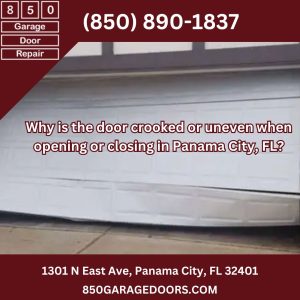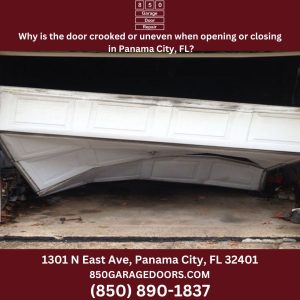A crooked or uneven garage door usually means that one side of the door is rising or lowering faster than the other. This imbalance is often caused by worn springs, frayed cables, or misaligned tracks. In coastal areas like Panama City, humidity, rust, and salt exposure can worsen these problems. Homeowners should take this issue seriously because an uneven door can strain the opener, damage the panels, and create a safety risk. Understanding the causes and solutions for garage door repair will help keep your garage door operating smoothly and safely.
Introduction
The problem: a garage door that opens or closes unevenly
When one side of your garage door sits higher or lower than the other, it’s a clear sign something is wrong with the system. A properly functioning garage door should move evenly along its tracks, maintaining balance from start to finish. If you notice it wobbling, scraping, or appearing tilted, it means that one or more parts are out of alignment or worn down.
Why this matters (for homes in Panama City, FL)
In Panama City, garage doors endure extra wear because of the region’s humid climate and salty coastal air. Metal parts such as cables, tracks, and springs can corrode faster than in drier areas. If ignored, these small imbalances can evolve into major problems, including a complete breakdown of your garage door system.
Recognising the symptoms
What a crooked or uneven door looks like
When your garage door opens or closes, you might notice one side moving slower or lagging behind. Sometimes the door may stop short of closing completely on one side, leaving a small gap near the floor.
Common warning signs: one side lags, door scrapes, gaps appear
- Visible gap between the bottom seal and the floor
- Grinding or scraping noises during operation
- One side appears lower when fully closed
- Door gets stuck mid-motion
- Opener light flashes or stops the process prematurely
Why you should pay attention sooner rather than later
An uneven door puts uneven pressure on the entire system. This can lead to broken cables, damaged rollers, and extra strain on your opener. Over time, that imbalance may cause your door to come off its tracks or fail completely, risking damage or injury.
The most common causes of a crooked or uneven garage door
Worn or broken springs (torsion or extension)
Garage door springs balance the door’s weight. If one spring weakens or breaks, one side of the door will lift slower, making it tilt or jam.
Frayed, loose or off-spool lift cables
Cables lift the door evenly on both sides. When one cable becomes loose, frayed, or slips off its drum, the door loses balance and one side will hang lower.
Bent, misaligned or loose tracks
Tracks guide the rollers up and down. If they bend or shift out of position, the rollers can’t move smoothly, and the door may tilt or bind.
Worn rollers, hinges or hardware
Over time, rollers and hinges wear out, causing extra play in the door movement. This can make one side wobble or shake when opening or closing.
Uneven floor or shifted foundation
In some Florida homes, settling foundations or uneven garage floors can make the door appear crooked even when the mechanism is functioning correctly.
Environmental factors specific to Panama City (humidity, salt air, storms)
Coastal weather can speed up rust and corrosion. Humidity weakens metal over time, and exposure to salty air can cause premature wear on springs and cables.
How each cause leads to the door being crooked
Springs losing tension – one side lifts slower
When one spring loses strength, it no longer supports its side evenly, making the door rise unevenly and tilt.
Cables giving slack – one side drops slightly – tilt
If a cable loosens, that side of the door will drop lower, throwing the entire system off balance.
Tracks not level or square – door doesn’t travel evenly
Misaligned tracks create resistance, so one side of the door moves more freely than the other.
Hardware wear – increased play, uneven movement
Worn rollers or hinges allow the door to shift from side to side, exaggerating unevenness during travel.
Floor/foundation shifts – door bottom seal or alignment affected
If your garage floor has settled or cracked, the door might appear crooked even when all hardware is working fine.
Coastal conditions in Panama City accelerating corrosion and wear
Rust caused by salty air leads to stiffness and uneven resistance across moving parts, which contributes to imbalance.
| Common Cause | Effect on Garage Door |
|---|---|
| Broken or Weak Springs | One side lifts slower, causing the door to tilt |
| Frayed Cables | Uneven lifting tension leads to imbalance |
| Bent Tracks | Door drags or binds on one side |
| Corroded Hardware | Movement becomes jerky or uneven |
| Foundation Shifts | Door appears slanted even when parts are functional |
What you can inspect or try yourself (safely)
Quick visual check: balance test, gaps, level
Disengage the opener and manually lift the door halfway. If it doesn’t stay in place, there may be a balance issue.
Lubricating rollers and hinges
Apply a light silicone-based lubricant to reduce friction and help the door move smoothly.
Checking for loose track bolts or hardware
Use a wrench to gently tighten loose track bolts, but avoid over-tightening which can cause misalignment.
Avoid doing major spring/cable work (safety alert)
Springs and cables are under high tension and can cause serious injury if handled improperly. Always contact a trained technician for these repairs.
When you should call in a professional
Broken spring or visible gap in spring coil
If you notice a visible gap in your spring or hear a loud bang from the garage, a spring has likely broken and needs replacement.
Cable that has come off drum or is frayed
A frayed or off-track cable must be replaced immediately to prevent the door from dropping suddenly.
Track that’s severely bent or out of alignment
If the track is visibly bent or detached from the wall, a professional should inspect and realign it.
Door that is unsafe, binding, or the opener is straining
A straining opener is a clear sign of imbalance. Continuing to use it may lead to motor damage or complete failure.
Trusted local service in Panama City: what to look for
Choose an experienced local company that understands Florida’s weather challenges, uses corrosion-resistant parts, and offers regular maintenance programs.
Preventive maintenance tips to keep your door level
Annual inspection of springs, cables, tracks, rollers
Have a professional check your garage door system once a year to catch early signs of wear or imbalance.
Cleaning and lubrication schedule
Wipe down metal parts every few months and apply a proper lubricant to keep the system smooth.
Keeping hardware tight and replacing worn parts
Loose bolts and worn rollers are often the first signs of trouble. Keep them tight and replace any damaged components quickly.
Protecting from salt air and coastal moisture (specific to Panama City)
Use corrosion-resistant lubricants and clean hardware regularly to remove salt buildup that accelerates rust.
What to include in your maintenance checklist
- Inspect cables and springs for rust or fraying
- Check door balance monthly
- Lubricate rollers, hinges, and tracks
- Look for water or salt buildup around the door
- Schedule a yearly professional inspection
Summary & takeaway
Recap of why doors go crooked or uneven
Most uneven doors are caused by worn springs, damaged cables, or corroded hardware. In coastal cities like Panama City, environmental factors make regular maintenance even more important.
The cost of ignoring the problem (safety, damage, cost)
Ignoring a crooked door can lead to costly repairs and safety hazards. A neglected imbalance can wear out the opener or cause the door to jam completely.
Action plan for homeowners in Panama City
Inspect your garage door regularly, keep parts clean and lubricated, and reach out to a qualified professional when you spot early warning signs.
Frequently Asked Questions
Can I just ignore it if the door still works?
No, even if the door still moves, imbalance causes hidden damage that worsens over time.
Will a new opener fix the problem?
Not necessarily. The issue usually lies in the door’s mechanical balance, not the opener itself.
How often should I have a pro check my door in a coastal region like Panama City?
It’s best to schedule a professional inspection once a year, or sooner if you notice uneven movement or corrosion.
Conclusion
A crooked or uneven garage door is more than an inconvenience. It signals that something within your system is failing or out of balance. By understanding the causes and acting early, you can avoid larger issues and maintain a safer, longer-lasting door. For expert help, homeowners in Panama City can trust the experience and reliability of 850 Garage Doors. Visit 850 Garage Doors to learn more about maintaining your garage door system.



